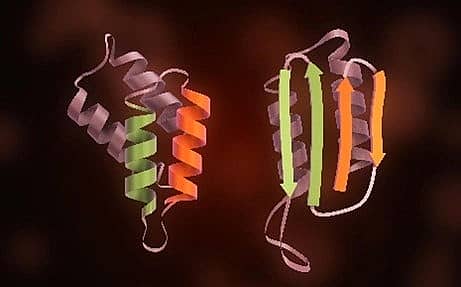Prion diseases, or transmissible spongiform encephalopathies (TSEs), are a family of progressive neurodegenerative disorders that affect both humans and animals. The term prion is derived from “proteinaceous infectious particle.”
A prion is a type of protein that can trigger normal proteins, most often in the brain, to fold abnormally. The abnormal folding of the prion proteins leads to brain damage and symptoms including memory impairment/dementia, personality changes, and motor difficulties.
The most common form of prion disease that affects humans is Creutzfeldt-Jakob disease (CJD) which causes a rapidly progressing dementia and other neurodegenerative symptoms. Research indicates that prion-like proteins play a critical role in the pathogenesis of Alzheimer’s disease.
In a laboratory setting, employees may be exposed to prions from research involving work with human brain and other central nervous system tissue, or from research with prions or prion-like proteins. Prions are primarily transmissible by inoculation and ingestion, but they can also be transmitted from aerosol exposure.
Per the BMBL, prions from human tissue, and human prions propagated in animals, should be handled at biosafety level 2 (BSL-2) or higher. For most work, BSL-2 enhanced is recommended, but the appropriate biosafety level must be determined by performing a complete risk assessment. Standard BSL-2 precautions are generally sufficient when working with non-human prion proteins or samples.
Wherever possible, the laboratory and equipment used for work with prions should be dedicated to that task alone. All employees should be informed and aware that prion research is being conducted in the lab. Other considerations include:
- Engineering controls: Work should be performed in a designated biosafety cabinet (BSC). If material must be fixed, a designated fume hood or ducted BSC should be used. There are also BSCs that can be outfitted with additional exhaust carbon filtration systems for fume scrubbing for use with very small amounts of chemicals.
- Personal protective equipment (PPE): In addition to standard laboratory PPE, other PPE is often recommended depending on the procedures being conducted, including the use of disposable lab coats, sleeve covers, and double gloving.
- Sharps use: The use of sharps should be minimized and only be used when no other alternative is available. If used, sharps should be handled with extreme caution to avoid autoinoculation during use and disposal. Used sharps must be immediately disposed of into a properly labeled sharps container. Needles should not be recapped, bent, sheared or broken.
- Centrifugation: Liquids potentially containing prions or prion-like proteins should be handled carefully to minimize the creation of splashes and aerosols. Centrifugation must be done in closed containers using sealed rotors or safety cups. Safety cups should be opened inside a BSC.
- Disinfection: Prions are characterized by their relative resistance to conventional inactivation procedures including irradiation, autoclaving, and harsh chemicals such as alcohols, standard bleach concentrations (10 to 20%), and formalin. Formalin-fixed and paraffin-embedded tissues, especially of the brain, remain infectious.
Solutions of either 40% bleach or 1 N sodium hydroxide can be used for effective liquid waste decontamination with a contact time of one hour. 40% bleach can also be used to wipe equipment surfaces and bench areas after experiments.
- Waste: Samples/solid waste containing prions should be kept segregated from other biological waste streams and be marked as “for incineration”. The biological waste hauler should be consulted before generating prion contaminated streams as they may require additional decontamination steps before removal and incineration.
If your research involves potential exposure to prions, please contact us for additional information on recommended safe work practices and assistance with prion-related safety training and risk assessments.
This blog was written by Beth Graham, Safety Partners’ Director of Quality, Research, and Training.


